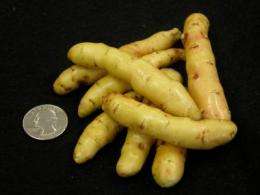Scientists map potato genome, hope to improve crop yield

It's been cultivated for at least 7,000 years and spread from South America to grow on every continent except Antarctica. Now the humble potato has had its genome sequenced.
"The potato is the most important vegetable worldwide," said Robin Buell, an MSU associate professor of plant biology. She was part of the consortium that released the first draft sequence of the potato genome. "This first draft that is being released will help breeders improve yield, quality, disease resistance and nutritional value."
The Potato Genome Sequencing Consortium, an international team of 39 scientists from 14 countries, began work on the potato genome project in 2006. The complete sequence is estimated to be 840 million base pairs, about one-quarter the size of the human genome. The draft sequence, which covers 95 percent of potato genes, is available at http://www.potatogenome.net and will be updated over the next six months.

Potatoes are members of the Solanaceae family, as are tomatoes, peppers, eggplant, petunias and tobacco. Buell, along with Dave Douches, an MSU crop and soil sciences professor, is leading a $5.4 million U.S. Department of Agriculture grant research project to improve the quality, yield, drought tolerance and disease resistance of potatoes and tomatoes. Known as the SolCAP project, the research aims to use emerging DNA sequence knowledge with basic research data to improve tomato and potato varieties.
"The timing of the release of the potato draft sequence is nice for the SolCAP project," Douches said. "We're combining genetics and breeding, so having a draft of the genome will help us find genetic markers for desirable traits in potatoes, which will make breeding more precise."
Buell is determining which genes are expressed in specific potato plant tissue to better understand the tuber's growth and development.
Buell's potato genome sequencing research is funded by the National Science Foundation and was done in collaboration with Chris Town, of the J. Craig Venter Institute, and Jiming Jiang, of the University of Wisconsin. The research of Buell and Douches also is funded by the Michigan Agricultural Experiment Station.
In 2007, more than 309 million tons of potatoes were produced around the world. China is the top global potato market, consuming about 47.5 million tons of potatoes in 2005. Belarusians are the leaders when it comes to savoring spuds, each eating an average of nearly 400 pounds of potatoes per year. The United States consumed slight more than 17 million tons of potatoes in 2005, which makes it the world's fourth largest potato consumer. Each person in the United States eats more than 119 pounds of potatoes per year.
Source: Michigan State University (news : web)















